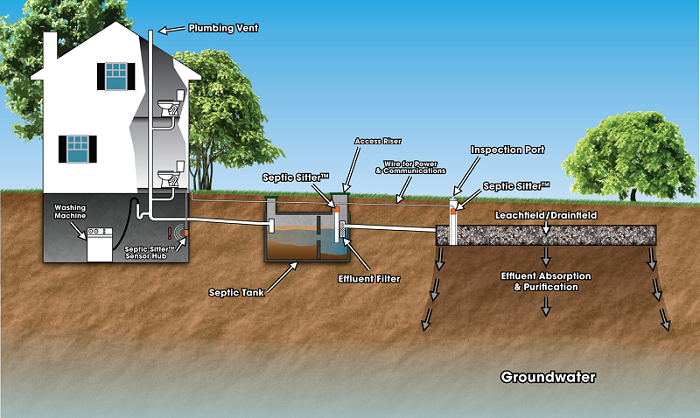SEPTIC TANK
Installing Septic Systems or replacing an existing Septic Tank can be expensive and stressful. There are regulations to adhere to, permits to get, and plumbing and environmental issues to take into account. It’s best to work closely with a licensed septic tank plumbing company such as AAA Pro Plumbing.
SEPTIC TANK INSTALLATION
Site Evaluation: The first step in a septic tank installation is to determine the size of a drainage field and septic tank your setup requires. Factors to consider in this are an estimation of the amount of wastewater your house will produce, and the inspection of the soil in your yard. Septic tank designers will examine your site in two different ways – with a percolation or “per test” or perform a site evaluation.
Septic System Installation: After you have checked all the local regulations and soil quality, got permits, and determined the size of septic tank you need, the septic system installation can begin. Installing a septic tank usually requires a backhoe to dig an adequate size hole since septic tanks are usually underground. Part of the initial installation is to plan for Inlet and Outlet pipes.
Make sure you know where the manhole cover is located. Many people use a manhole riser to bring the cover near the surface of the ground.
LEACH FIELD
The leaching field size is dependent upon several factors including septic tank size, soil type and absorptive capacity, and the wastewater absorption technology you will be using.
The leaching field location in your yard will be determined by local regulations, slope of your yard and where your home is located on that slope, and the soil composition in varying parts of your yard.
SEPTIC INSPECTION
A septic inspection is a necessary procedure for any home that uses one. New homebuyers should always have a septic tank inspected on a property they are considering buying in order to determine if the septic system is working properly. Most septic inspections are done without digging up the septic tank and system parts in order to verify that it is working properly.
SEPTIC TANK MAINTENANCE
There are several common problems that result from poorly maintained septic systems, even though they are designed to last for decades. Foul odors, inadequate filtering of wastewater, and leakage of toxic solids from the septic tank.
The following are steps to maintain a septic tank:
- Pumping and Cleaning Tank
The number one maintenance task for a septic tank is pumping or cleaning your tank out every 2 to 5 years. It’s as simple as calling your septic company and asking them to schedule a pumper truck to your property. They will vacuum out the seepage in your septic tank, and will haul it to a sewage treatment plant for disposal.
Record the date of the pumping so you know when to schedule your next pump out. Also keep records of where the manhole cover is located so you know where it is the next time.
- Inspect Tank and Leaching Field
Some local governments require inspections before selling homes with septic tanks. You should have the tank and leaching field inspected each time you get the tank pumped. Many drainage issues can develop, including severe root growth, damaged or crushed pipes, and sludge blockage. If these issues are not addressed, they can result in costly damage to your absorption field.
- Minimizing the Waste your Septic System Takes In
Reducing the volume of wastewater and solids that enter your septic system can often increase the tanks lifetime. Ways to do this include minimizing water usage, reducing use of a garbage disposal, and avoiding regular use of chemicals such as water softeners and drain cleaners, which kill the bacteria your septic system relies on.
TYPES OF SEPTIC TANK PROBLEMS
- Broken baffles
- Clogged or broken lines
- Distribution box unleveled
- Faulty floats
- Faulty pumps
- Full drainfields and dry wells
- Leaking concrete tanks
- Metal tank malfunctions
- Slow drainage
- Solids build-ups
SEPTIC TANK CLEANING
If your septic tank is emitting foul odors or is not working properly, it probably needs a good cleaning. Below are indicators that your septic requires cleaning.
- Backed up septic tank
- Clogged septic tank
- Drain field dry
- Dirty septic filter
- Odors near septic tank
The Department of Health and Safety recommends your septic tank be cleaned on a regular basis, at a minimum of every three to five years, depending on usage. Factors that affect how soon your septic tank should be cleaned include household size, septic tank maintenance, and garbage disposal usage.
HOW DO SEPTIC SYSTEMS WORK?
All water sources from a property are routed into the septic tank. This includes water from the bathtub, sink, shower, toilet, and any other water source.
The septic tank traps the solids and allows the cleaner water to pass through to the drainage or leach field area. The solids that are trapped need to be removed with pumping and regular maintenance. If the solids are not pumped out as needed, they will build up and make their way into the drainage area.
The cleaner water that passes through then goes to a box that distributes the water uniformly to the drainfield. Drainfields are dug and filled with limestone. Drain or Leach fields are ditches can range from 60 feet to 100 feet in length, and vary in size and depth.
A pipe runs from the distribution box to the drain field pipe. The water is released through the drainfield pipe, which has holes in the bottom. The water drips out of the pipe and into the limestone. The limestone cleans the water before it enters the ground and water table.


